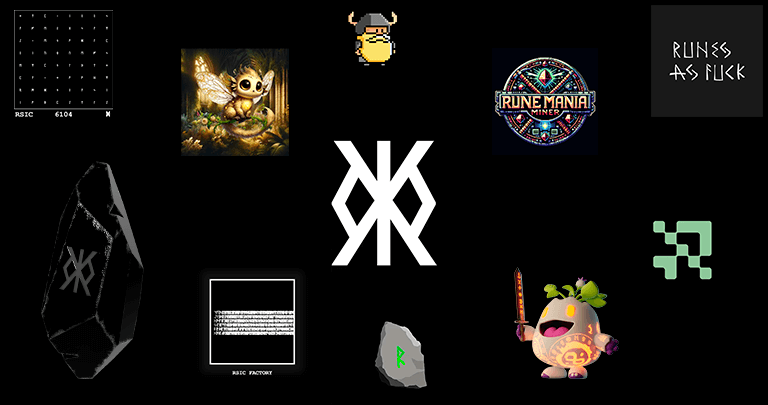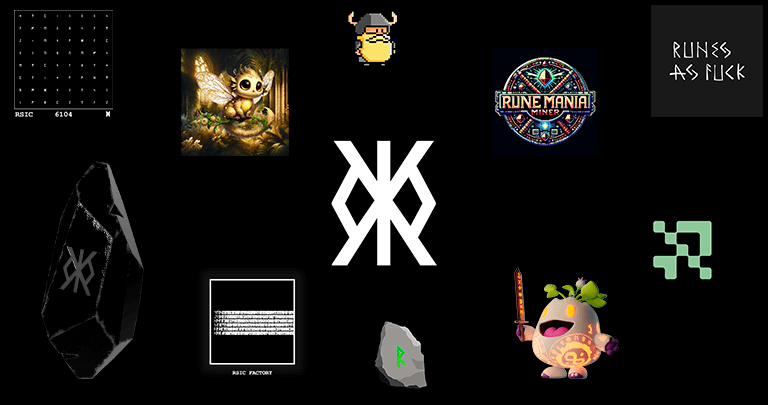A year ago, we wrote about Ordinals, now comes Runes, so get ready


About a year ago, we
wrote here on the Visionnaire Blog about Ordinals [1]. It's even funny to look back to a time when Bitcoin NFTs didn't even
exist, and see how much the Bitcoin world has changed after the advent of Ordinals in the largest Blockchain. Now, we are
on the eve of the arrival of Runes, which will revolutionize, just like Ordinals, the world of Bitcoin.
But, before talking
about Runes, let's quickly review Ordinals. In almost a year of existence in the market, we had almost 70 million inscriptions
(which can be compared to NFTs, but can also be any file format), more than US$3 billion in market volume, more than 500,000
unique users, several Marketplaces, and countless success stories of companies and startups, which didn't even exist a year
ago, already making millions and operating exclusively in this market [2]. In recent months, the volume of Bitcoin NFTs has
surpassed classic market Blockchains, such as Ethereum and Solana, in daily volume [3], with classic collections like Crypto
Punks and Bored Ape Yacht Club being overtaken by the largest Bitcoin NFT collections, such as Node Monkes and Bitcoin Frogs
[4]. Not bad for an infant of just one year.
What are
Runes?
If Ordinals are a way
to create Non-Fungible Tokens (NFTs) in Bitcoin, Runes are a way to create Fungible Tokens (FTs) in Bitcoin. “Fungible”
Tokens, unlike “Non-Fungible” ones, can be replaced by something else of the same kind, quality, quantity,
and value. For example, a US$1 bill can be exchanged for another note of the same kind, which continues to have the same value.
Runes [5], a standard
developed by the same creator of Ordinals, Casey Rodarmor [6], were mainly thought of because the largest number of Ordinals
inscriptions are text format inscriptions (and not image format that resembles NFTs in other Blockchains), and these text
format inscriptions, for the most part, are JSON texts wanting to mean something that other standards understand [7].
Another reason for the
creation of Runes is that Casey does not like the BRC-20 standard, which is the main one for Fungible Tokens in Ordinals.
The BRC-20 (in reference to ERC-20, the standard for creating Tokens in Ethereum, which means Ethereum Request for Comments)
was created by Domo, another talented developer in the Crypto world [8], who initially called it an “experiment”, but
it was adopted so quickly by the community that it was not possible to hold back or plan better. Casey first did not like
to see so many JSONs [9] in the garden he created (Ordinals), especially since the protocol used in these JSONs was, for the
most part, BRC-20, a protocol that, according to Casey, is not so good. For these and other reasons, the need for a new standard,
a new protocol, what came to be the Runes.
Runes,
Origin of the Name and Functioning
Where does the name
Runes come from? Yes, it comes from the letters of the original runic alphabet of northern Europe from the 2nd century [10].
The Runes are the letters, originally only 24, and which, over time, fell into disuse due to the adoption of Latin. Nowadays
there is a whole mystique related to the Runes (according to historians, the mystique comes from before the creation of the
Runes, from their origins, like Viking legends), and are very well known in the Gaming community and in fiction movies. But
we are not here to talk about history, it’s about Bitcoin.
The Runes standard will
come into effect in the Bitcoin world starting from Block 840,000. Why from that block? Because it will be the block where
the halving of the BTC (Bitcoin) currency prizes awarded to miners for the creation of each block will occur. Bitcoin was
conceived by its creator (Satoshi Nakamoto) in this way, with the current BTC prize being 6.25 BTC, and when the next halving
occurs, it will go to 3.125 BTC. This is expected to happen in the next few weeks, on April 18, 2024, and Casey used this
event as symbolic for the start of Runes operations.
Runes will operate on
top of Ordinals and will have a functioning similar to BRC-20, but better. Some of the features that Casey envisioned for
Runes, which are considered better in his view, are [11]:
• Simple
– the core of the protocol has 500 lines of code
• Compact – messages fit in 80-byte returns
•
Extensible – updates to the protocol are easy
• Atomic – all operations require only
one transaction
• UTXO-based – a natural extension of Bitcoin
• Electric –
can easily upload to the Lightning network
• Lightweight – supports simple payment verification
•
Expressive – Runes can be child inscriptions.
Casey also points out
the following advantages of Runes compared to BRC-20: fewer transactions, having a reference implementation, being extensible,
being simple, having better name support, having names that do not conflict, and being safer. He has also sought to explain
about Runes before they go live [12].
Regarding names, Runes
will start with a minimum size of 12 characters, which over time will decrease to 11, 10, and so on. The purpose of this was
to try to avoid speculation on names of famous coins at the beginning, like Doge, Pepe, or Ordi.
Runes and
Memecoins
But won't this new standard
be used for what some call the scum of the Crypto world, the Memecoins (also known as Shitcoins in some cases)? And the answer
is yes, it will be used. Of course, the main reasons cited for the creation of Runes are the ones mentioned above, but, deep
down, one of the things that was wanted (perhaps in parallel or as a backdrop) was a better environment for Memecoins, and
why not, a better environment for what the creator himself called Bitcoin “A Peer-to-Peer Electronic Cash System” [13].
Yes, Runes will revolutionize
Bitcoin, they will revolutionize Tokens, they will revolutionize Memecoins, some say we are about to see “The biggest
casino in the world!”. I may be wrong in this prediction (but the cool thing is to predict before the event, the sooner,
the cooler), but in a year Bitcoin will be the largest market for Memecoins and any other coins that come to exist.
Visionnaire
in the Bitcoin World
Just like when Ordinals
came about, Visionnaire has been a pioneer in pointing out trends and effectively working on these new technologies. This
is in our name, our origin, and our culture [14].
Even being modern technologies,
we already have real experiences in the world of Blockchain, Crypto, and Bitcoin, including cases along with the use of Machine
Learning and AI (Artificial Intelligence).
If your company needs
to navigate these new seas, you can count on Visionnaire. We can help from consulting, through training or team capacity building,
to the construction of modern solutions, in production, for your need. Count on Visionnaire to be your partner company in
the world of Bitcoin, Ordinals, Runes, and Blockchain in general! Contact us here.
Sergio Mainetti Jr.
Notes:
[1] Bitcoin Ordinals
- Has the Giant Awakened? Blog
written in March 2023.
[2] Sources: Ordinals.com and Dune Dashboard
Ordinals Marketplaces.
[3] Source: Blockchain
View by Crypto Slam.
[4] Source: Best in Slot.
[5] Runes summarized
documentation.
[6] For more information
about Casey Rodarmor, see here and his account on X (Twitter) here.
[7] To consult the volume
of inscriptions by type, see here.
[8] For more information
about Domo, see his account on X (Twitter) here and his Dashboards on Dune here.
[9] To learn more about
JSON, consult Wikipedia here.
[10] To learn more about
Runes, see the Wikipedia page on the subject here.
[11] Casey Rodarmor's
presentation on Runes at the Sora
Summit in Taipei, Taiwan, in December 2023.
[12] Casey explaining
about Runes on his Podcast. Casey participating in a Q&A session with the main influencers of the Ordinals community,
Twitter version here, Spotify version here.
[13] The original Bitcoin
article, “A Peer-to-Peer Electronic Cash System”.
[14] Visionnaire's Vision
and Mission can be found here.




